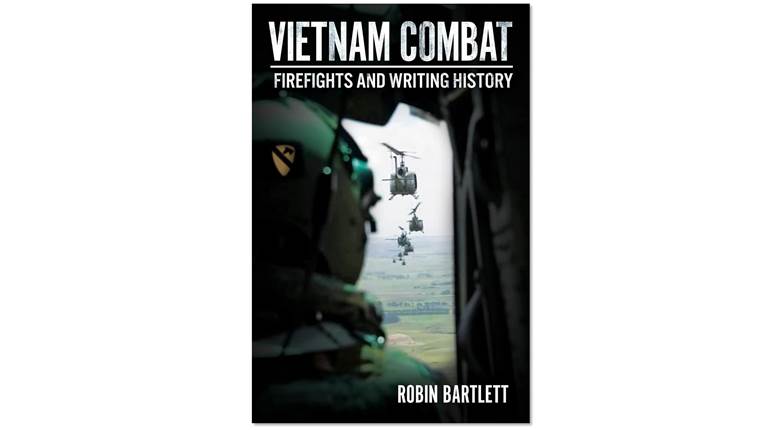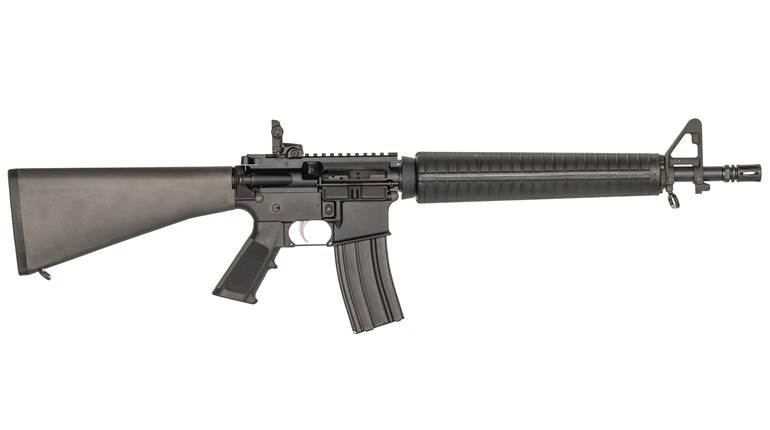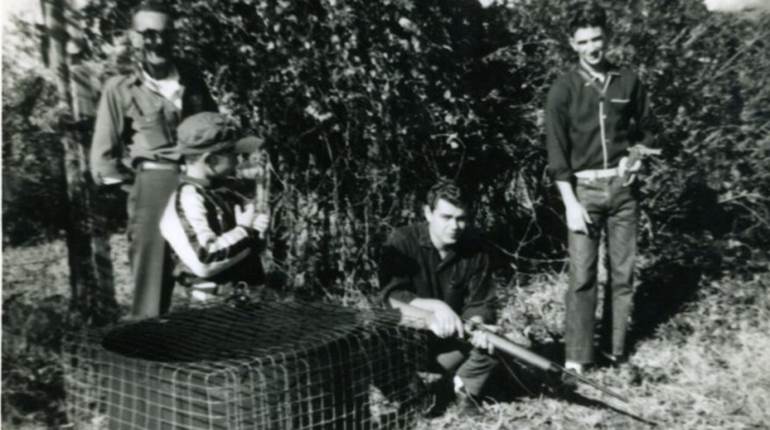
This article was first published in American Rifleman, March 2002
The use of shotguns by American fighting men predates the American Revolution when smooth-bore flintlock “fowling pieces” saw some combat use, primarily by irregular troops. Shotguns continued to see a surprising amount of military use, albeit “informally,” during the War Between the States and into the “Indian Wars” period. Some shotguns were purchased by the government for “foraging” purposes, but a number of privately owned shotguns accompanied some soldiers into combat during this period.
The first official procurement of shotguns as combat arms by the U.S. government occurred around the beginning of the 20th century when a couple hundred standard, short-barreled, commercial Winchester Model 1897 slide-action, 12-ga. “riot guns” were issued to American troops fighting in the Philippines. The guns proved to be of enormous benefit against Moro tribesmen in the close-range jungle fighting common to the Philippine “pacification” campaigns.

The United States military again turned to shotguns when the nation became embroiled in World War I. The tried and proven Model 1897 was slightly modified by the addition of a ventilated metal handguard and bayonet adapter and was referred to as the “trench gun.” The Winchester Model 1897 12-ga. trench guns, along with a smaller number of Remington Model 10 trench guns, saw action in the trenches of France during the closing months of the war. The trench gun soon garnered a reputation as a fearsome close-range arm, and the Germans even lodged official diplomatic protests against its use.
Following the Armistice in 1918, the trench guns remained in the inventories of the U.S. Army and Marine Corps where they saw use in some “hot spots” in the Caribbean and China “between the wars.” The supply of shotguns left over from World War I was sufficient to meet the demand until the eve of World War II.
The Pearl Harbor attack found the United States military woefully short of all manner of arms. The World War I-vintage shotguns were about a quarter century old by that time, and the supply was insufficient to meet the burgeoning demand. The Ordnance Department gave contracts to several commercial firms for shotguns. There were three basic types procured during World War II; trench guns (with bayonet adapters and handguards), riot guns (plain, short-barreled guns) and longer-barreled trap or skeet guns (for training aerial gunners and for recreational use). Winchester Repeating Arms Co. supplied Model 97 and Model 12 shotguns of all three types. Ithaca Gun Co. produced a small number of Model 37 trench guns and a larger number of Model 37 riot guns and training guns. Stevens Arms Co. delivered trench gun, riot gun and training versions of its Model 520-30 and 620A shotguns. Remington Arms Co. turned out riot and training gun variants of its Model 11 autoloading shotgun, and Savage Arms Co. produced a number of the almost-identical Model 720 riot guns and training guns. Some of these shotguns saw combat use in most theaters of the war and, as was the case in World War I, they proved to be highly effective for close-range combat applications.

Even though large numbers of military surplus shotguns were sold on the civilian market after World War II, there were sufficient numbers on hand to meet the needs of the military from the end of the war until the early 1960s. After World War II, the only combat shotguns that remained classified as “Standard” were the Winchester Model 12 “trench gun” and the Stevens M520-30 and M620A “trench guns.” It should be noted that the term “trench gun” was not an official classification but was, and is, widely used to identify a short-barreled shotgun fitted with a handguard and bayonet adapter.
When the United States stepped up the deployment of troops to Southeast Asia beginning in the early 1960s, it was recognized that shotguns could be of value for fighting in the jungles and similar terrain. The World War II-vintage trench guns (and some riot guns) were refurbished as necessary, and many were sent to Vietnam. Most of those guns were Parkerized, and any worn or defective parts were replaced as part of the overhaul process. The refurbished World War II shotguns that saw the most use in Vietnam were the Winchester Model 12 and Stevens M520-30 trench guns. A few Winchester Model 97 shotguns saw use during this period as well—even though most of them had been disposed of as surplus by the government in the late 1940s.
Even with the “recycled” World War II guns in inventory, it was obvious that the supply was going to be exhausted before too long, and contracts were given for the procurement of new shotguns.
Ithaca Model 37
The first of these new contracts was given in 1962 to the Ithaca Gun Co. for a plain-barrel riot gun version of its popular Model 37 slide-action shotgun. Ithaca had previously manufactured shotguns for the U.S. government during World War II. The Vietnam-era Model 37 riot gun was serially numbered in a special range (approximately 1,000 to 23,000 with an “S” prefix to the serial number and marked with a “U.S.” on the receiver and “P” proof markings on the receiver and barrel). Unlike the World War II shotguns, the Vietnam-era Model 37s were Parkerized rather than blued. The guns had 20" barrels and plain, unadorned stocks with plastic buttplates and no sling swivels. One of the most notable features of the Model 37 design was the fact that it did not have an ejection port in the right side of the receiver, but rather loaded and ejected from the bottom. This design helped keep dirt and mud out of the action as compared to most other standard slide-action shotgun designs that utilized an ejection port in the right side of the receiver.
Except for the markings, those military-contract shotguns were essentially identical to the Model 37 riot guns made for civilian and police use during that same period. Approximately 22,000 of these Model 37 “S-prefix” riot guns were manufactured by Ithaca under the U.S. Army contract.

A few years later, some additional Model 37 riot guns were procured by the government. These guns were basically the same as the civilian riot guns of the period and were not numbered in a unique range (as were the “S-prefix” Model 37 riot guns). A few of these later Model 37 riot guns were equipped with sling swivels and some were subsequently fitted with “duckbill spreaders” (shot diverters) for use primarily by U.S. Navy personnel, including “SEALs.”
Around 1967, the government procured a quantity of Model 37 “trench guns” from Ithaca. These were similar to the riot guns but were fitted with a ventilated metal handguard/bayonet adapter and sling swivels. A very similar Model 37 trench gun was manufactured by Ithaca under government contract during World War II, but they differed from the Vietnam-vintage guns in that the latter had Parkerized finishes and somewhat different martial markings. Most of these later M37 trench guns made under government contract were serially numbered in the high 900,000 range and were marked “U.S.” on the receivers. The number of Model 37 Vietnam-era trench guns procured under government contract has not been verified but was likely only a relatively small quantity—certainly no more than a few thousand. Some identical guns were sold on the civilian market as well, but these were not “U.S.”-marked and were generally in a higher serial number range.
Interestingly, the bayonet adapter for the Model 37 trench gun was designed for use with the M1917 “U.S. Enfield” bayonet. This bayonet was selected for use with the first “trench guns” used in World War I and remained the standard shotgun bayonet in U.S. military service until the late 1960s. Since the supply of World War I M1917 bayonets was almost exhausted by that time, contracts were given to two firms, General Cutlery, Inc., and Canada Arsenal, Ltd. The bayonets made by these firms were not as well-crafted as the World War I bayonets and were fitted with checkered plastic grips. In addition to the new-production bayonets, some refurbished World War I M1917 bayonets were issued for use in Vietnam.

Stevens Model 77E
To supplement the Ithaca Model 37 riot guns, the government contracted with the Stevens Arms Co. around 1963 for a riot gun version of its slide-action shotgun, designated as the M77E. The M77E shotguns had 20" barrels and were marked “U.S.” on the receivers with small “p” proof marks on the barrels and receivers. The guns were Parkerized, and the wooden stocks were fitted with rubber buttpads. Most of the stocks were noticeably shorter than standard U.S. shotgun stocks to accommodate our typically smaller-statured South Vietnamese allies. The M77E was the first United States combat shotgun equipped with a rubber recoil pad. The M77E was also fitted with sling swivels. Early examples had the front swivel mounted on a band affixed to the barrel and later guns had the front swivel attached to the magazine plug base. Unlike the Ithaca M37, the M77E was a conventional slide-action shotgun design with an ejection port on the receiver’s right side.
With more than 50,000 M77E riot guns manufactured, the Stevens M77E was the most widely used shotgun of the Vietnam War. It generally gave satisfactory service but proved to be a bit less reliable and durable than the Ithaca M37. The attachment of the buttstock to the receiver was rather weak and resulted in a number of guns being broken. The M77E riot guns were issued to U.S. Army and Marine military personnel as well as to some South Vietnamese troops.

In addition to the M77E, a fairly small number of Stevens 69R riot guns was purchased by the government in the late 1960s. The 69R was similar in design and performance to the M77E, but it saw only a modicum of use as compared to the much more widely issued M77E. A very small number of prototype M77E trench guns (riot guns fitted with bayonet adapters) were procured, but few, if any, were issued. The standard riot gun version of the Stevens M77E along with the Ithaca M37 were the most commonly issued combat shotguns of the Vietnam War.
Winchester Model 1200
As the war in Southeast Asia continued, other types of shotguns were procured by the U.S. military. In the late 1960s, the U.S. Army contracted with Winchester Repeating Arms Co. for a quantity of the firm’s new Model 1200 shotguns. The M1200 was intended as a replacement for Winchester’s legendary Model 12, which had proven very costly to manufacture. The M1200 slide-action shotgun was a rather conventional design that featured an alloy receiver to make the gun lighter and to reduce production costs.

Winchester developed a trench gun version of the M1200 that utilized a ventilated handguard/bayonet adapter reminiscent of the type used by the firm in World War I and World War II on its Model 97 and Model 12 trench guns. The M1200’s adapter was still designed to use the venerable 1917 bayonet. The M1200 military trench gun had a dull anodized finish on the alloy receiver and the steel barrel and handguard assembly were gray Parkerized. The barrel was marked with a “U.S.” on the right side and the receiver bore a “U.S.” marking below the serial number near the loading port. There were also some “riot gun” versions (without ventilated metal handguard/bayonet adapter or sling swivels) of the M1200 procured by the U.S. military.

The M1200 combat shotguns first saw issue in the late 1960s, and they still remain in limited use today by the U.S. Army.

Remington Model 870
The U.S. Navy and Marine Corps also required additional quantities of combat shotguns in the late 1960s. Contracts were given to the Remington Arms Co. for short-barreled “riot gun” versions of its M870 slide-action shotgun. The M870 was a popular sporting and police shotgun due to its reliability and smooth action. It was used by Navy personnel in Vietnam, including SEALs, and a number were issued to U.S. Marine units.
There were several variations found in military M870 shotguns of the era including Parkerized and blued finishes, solid plastic buttplates, rubber buttplates and a variety of marking formats. Many were stamped with U.S. Navy property markings.


A very interesting variant of the M870 was the “Mark 1” which was adopted by the U.S. Marine Corps in the late 1960s. The M870 Mark 1 was fitted with an adapter that allowed the M7 bayonet (the bayonet used with the M16 rifle) to be attached. The Mark 1 shotguns had 21" barrels and were equipped with extended magazine tubes (eight-round total capacity), rifle sights and sling swivels. The Mark 1 remained the standard USMC combat shotgun until just a few years ago when they began to be phased out and replaced by Mossbergs and other shotguns.
Although the Ithaca M37, Stevens M77E, Winchester Model 1200 and Remington Model 870 were the primary “official issue” combat shotguns fielded in Vietnam, there were isolated instances of shotguns purchased from PXs and other private sources being carried “in the field.”
Ammunition
The most common type of combat shotgun ammunition issued during the early stages of the Vietnam War was World War II-vintage “M19” shells. These were all-brass 12-ga. shells loaded with 00 buckshot. Although durable and water-resistant, much of the supply sent to Southeast Asia was poorly stored and a large amount had to be discarded due to corrosion.
The standard sporting shotgun shells of the period had plastic cases that were also water-resistant and durable, and they were all but immune to corrosion. In addition to these positive attributes, they were much cheaper than the earlier all-brass variety. Plastic 00-buckshot ammunition was adopted by the U.S. military and initially given the designation “Shell, Shotgun, Plastic Case, 12 Gauge, No. 00 Buck, XM162.” The shells were typically packaged in 10-round cardboard boxes. Twelve 10-round boxes were packed in a metal ammunition can. The individual shells were standard 00-buckshot shells (red plastic cases) indistinguishable from sporting ammunition of the same variety.
It was determined that smaller size shot, such as “No. 4 Buckshot,” would be better suited to certain types of combat situations than the standardized 00-buckshot. To this end, ammunition of this type was adopted as “Shell, Shotgun, Plastic Case, No. 4 Buck, Special, XM257.” Early versions of the XM257 shells were red plastic with the nomenclature stamped on the outside while later production shells were made of green “subdued” colored plastic. The XM257 No. 4 buckshot was packaged in the same type of 10-round boxes as the XM 162 No. 00 buckshot, and both types of No. 4s were used more or less concurrently from the time of adoption through at least the early 1990s.
M1938 shotgun shell pouches were procured to carry the shotgun shells, and several firms were given contracts to produce them. This was the same type of shotgun shell pouch first adopted in 1921 and widely issued in World War II. The pouches held 12 shells in internal web loops. Due to their limited capacity, they were reportedly seldom used, and most soldiers carried shotgun shells in M16 magazine pouches or other containers, or simply stuffed handfuls in their pockets.
Summary
While not well suited for all types of combat applications, shotguns proved to be of value in many engagements during the Vietnam War. Night ambushes and perimeter defense were two applications in which shotguns especially excelled. It is reported that American units armed with shotguns had higher “body counts” than similar units without shotguns.
After the United States’ withdrawal from Vietnam, combat shotguns remained a part of our armed forces’ inventory. Some of those used in Vietnam, especially the Ithaca “S-prefix” and Stevens M77E shotguns, are seldom encountered today because the majority were left in Southeast Asia.
While the M14 and M16 were the primary infantry small arms of the Vietnam War, the various combat shotguns also provided valuable service to our fighting men on many occasions. In certain combat situations, there is no deadlier arm than a slide-action shotgun loaded with buckshot. Many Viet Cong and North Vietnamese discovered what German troops found out in the trenches of France during the World War I and what the Japanese realized in the jungles of the Pacific during World War II: A determined American with a shotgun is a fearsome opponent indeed!




































